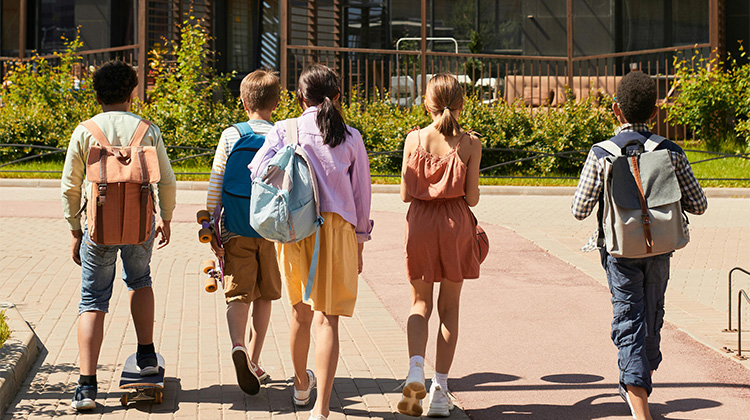An Expert’s Top Tips to Ease Back-to-school Stress

With the summer holidays firmly in the rearview mirror, students up and down the country are settling back into their school routines. For some students, the return of the school year is met with excitement about seeing their friends and returning to learning. School is a place for these students to be challenged, set new goals, and accomplish them.
However, for many students, school is a place to be on high alert. It’s a place where social uncertainty in relationships, miscommunication with teachers, and worry around their ability to complete academic tasks make school feel the complete opposite of a safe haven.
When these students are on high alert, their bodies’ stress responses can trigger further warning signs of escalation, dysregulation and fear. Students can be preoccupied about the durability of their relationships or their inability to develop academic persistence and often feel like their teachers fail to recognise their character strengths.
This fear can be all-consuming and mobilise the precious bodily resources away from learning, leading to a catastrophising thinking style that can remain anchored within the student. Here are five tips for educators looking to help their students navigate this potentially difficult time.
Recognise the Reasons for Students’ Stress
The first step is to recognise that all students, at various developmental stages, may experience stress overload. In fact, 72% of Australian children and young people have experienced at least one adverse childhood experience of stress overload.
Be mindful of the impact that adverse childhood experiences, such as violence or bullying, can have on students’ wellbeing and resilience. Wherever possible, acknowledge that loneliness and psychological distress are prevalent among young people, and react with a sense of compassion, openness and willingness to listen.
Consider the rapid growth of children into adolescence, where their brains are rapidly forging new connections for thinking and feeling. It is the job of the adolescent to feel as many emotions as possible to grow in healthy ways - and it's our job as educators to help our students process and understand those emotions.
Help Build Predictable Routines
Establishing and maintaining routines is paramount in helping students navigate the challenges of school and avoid unnecessary stress. Routines provide a sense of stability and predictability, creating a structured environment that allows students to feel secure and in control.
Within our practice, we suggest prioritising greeting students individually each day as they enter the classroom, and ensuring that students feel recognised. Teachers should develop clear class routines for transitions between lessons, the setup of any required class materials, and group work.
Most importantly, it’s critical to promote an environment where students feel comfortable seeking additional support in front of their friends without the fear of embarrassment.
Design Structured, Easy-to-follow Lesson Plans - From The Students’ Perspectives
Learning can feel uncertain, so we encourage a structured lesson plan that is chunked into sections that the student can easily predict and follow. Our research points to the importance of clearly delineating when students should focus, take breaks, and engage in active learning individually and then in small groups.
Lesson plans should be structured into easily digestible sections to mitigate uncertainty for students. ‘Brain breaks’ including stretching, mindful breathing, priming activity that relates to the lesson’s vocabulary, and other forms of bodily movement can help to renew focus and help students who struggle with long stretches of concentration.
Set up Set-regulation Stations
Teachers should also consider setting up proactive plans for students to help them self-regulate throughout the school day. We’ve seen a lot of success with 'self-regulation stations' for students. This involves creating an area equipped with fidget tools (not toys!) and quiet learning spaces, in an area located close to teachers’ viewing. This aids students in navigating heightened emotions during the learning process.
Build Regular Check-ins
For students, consider introducing regular check-ins as a means of building support and trust. Check-ins can be one-to-one short conferences, small group meetings or short classroom meetings lead with the prompt: How are we all travelling? What strategies do you suggest we can enact as a class to support ourselves this term? Schedule proactive meetings that empower students to self-regulate, providing consistent recognition of their strengths throughout the week. Offer fix-it feedback wherever possible, reinforcing strengths and addressing areas for improvement.
By adopting these strategies, educators can play a pivotal role in creating a nurturing and less stressful learning environment. This, in turn, will help students navigate the challenges of the new school year with confidence and resilience, fostering an atmosphere conducive to academic and personal growth.
About Berry Street
Berry Street is a child and family services organisation helping children, young people and families who are experiencing poverty, violence and abuse. Its focus is to help families stay together in safe and healthy homes so they can create the future they imagine for themselves.
Most support systems only kick in when families reach crisis point. Berry Street is working to shift priorities so that children and families get support when they need it, and victim-survivors get the help they need to recover.
About Dr Tom Brunzell
Dr Tom Brunzell has experience as a teacher, school leader, researcher and education advisor. Currently he is the Director of Education at Berry Street and Honorary Fellow at the University of Melbourne Graduate School of Education. Dr Brunzell presents internationally on topics of transforming school culture, student engagement, trauma aware practice, wellbeing and positive psychology, and effective school leadership.
His research at the University of Melbourne investigates both the negative impacts of secondary traumatic stress and the positive impacts of wellbeing on teachers and leaders working towards educational equity in their communities.
His book: Creating Trauma-informed Strengths Based Classrooms, co-authored with Dr Jacolyn Norrish, is now available as part of Berry Street's professional development resources and bookstore, as well as booksellers world-wide.
Image by Norma Mortenson